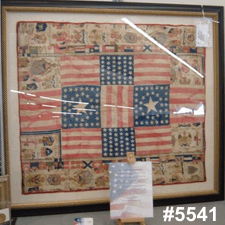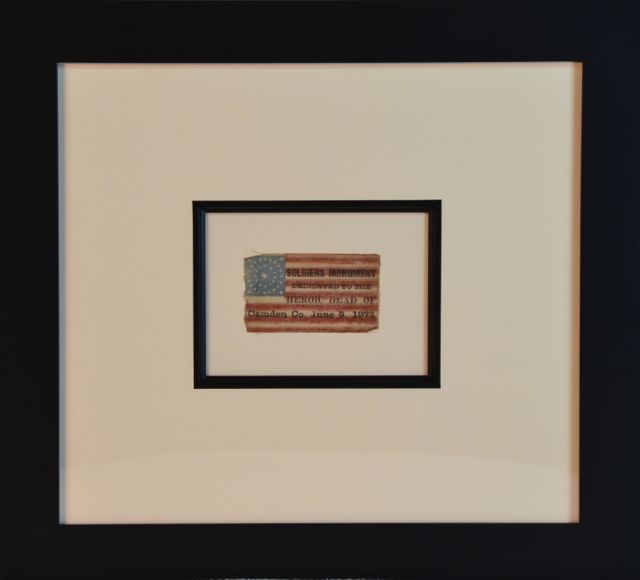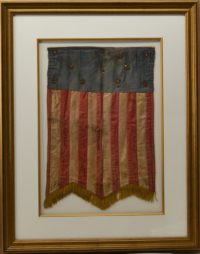Description
39 Star Antique American Flag Quilt 1876 #SKU 5541
Fantastic piece of rare Americana. A centerpiece for any collection
Very rare one of a kind Centennial Quilt. Made from four historical and hard to find 39 Star United State Flags with rare medallion star arrangement and other scarce period patriotic textiles from the 1876 Centennial.
The flags used in the quilt were patented in 1875. This quilt was made for the 1776 – 1876 American Centennial. Two of the flags are very rare medallion flags that are square in shape which is rare with a very large center star. The other two are the canton of two 39 star flags that stars positioned into a square which is very rare.
Antique flags with a Medallion star arrangement date to at as early as 1827, and at latest 1912. The majority of medallion pattern flags, however, date to between 1861 and 1876. During this period, many flag makers would include a center star, surround it with one or more wreaths of stars, and then surround the wreaths with flanking stars (i.e., corner stars). Beginning in the 1890s, the beautiful medallion patterns became less common, and linear arrangements became the norm. Why this occurred is unclear, as flag makers had the freedom to place the stars however, they liked until 1912, when President Taft issued Executive Order 1556 establishing the arrangement of the stars into rectilinear rows.
The stripes are individually hand cut and treadle sewn together, and are treadle sewn together. Treadle stitching was a sewing method commonly used in the 1830s The technique became relatively common by the 1860s, particularly for sewing the stripes, cantons, hoists, and edges of pieced-and-sewn flags.
The stars are made of cotton, and they are handsewn to both sides of the canton (i.e., double appliqued). Prior to Singer’s introduction of the electric sewing machine, flag makers using machine stitching had to place each star on the canton, fold its edges under, pump a treadle machine—and while doing all of this—properly move both the star and canton through it. Because of these difficulties associated with early sewing machines, until 1885, stars were commonly applied by hand—as is the case with this flag.
The 1876 Centennial was a major event in the United States. It was actually a world’s fair where all the major countries in the world came to set up exposition buildings to feature the products they sold around the world. This centennial event was very important for the United States as it showed the world and the major world powers that the United States was their equal.
President during this event was Ulysses S. Grant.
Very rare piece of authentic antique American Americana.
Flag size is 35” x 40”
Frame size is 40” x 46” (Outside dimension)
Selling only Genuine Authentic antiques & rare American Flags
I have consulted with numerous museums across the country including The National Archives, PBS, various film production companies for national TV Shows, major motion pictures, major collectors, and large and small auction houses over the years in selling, loaning, describing, documenting, and identifying various antique flags and antique textiles.
I have been interviewed for many national magazines and newspaper articles on antique flags and rare Americana.
Our flags and rare Americana have been featured in numerous antique trade publications, newspapers and major national decorator magazines, national TV shows and major movies.
I have also worked with numerous major retail corporations, major on-line retailers, major on-line catalogs, many prominent national interior designers, and architects.
Historical Americana has been buying and selling rare, unique antique relics and rare American Flags and Americana for over twenty years. I have personally seen and handled and purchased thousands of antiques & antique flags over the years.
We use modern museum framing technology to frame our antique flags.
Please do not be intimated by dealers that have outrageous prices on their flags and say if any flags is sold for less than their (highly inflated prices) it can’t possibly be real. Really?…
If you want to pay more for the same flag, please do
I have more experience on antique flags than most museum curators, auction house appraisers who may see only a few flags each year and most flag dealers sometime make erroneous statements and opinions on flags because of lack of experience.
Conservation
Our in-house professional framers use only conservation framing methods used by museums. We only use acid free cotton rag mats and gas free materials along with safe ultra-clear UV acrylic. The UV acrylic is clearer than glass and unlike glass it will not break. Our flags are museum mounted using safe acid free hinges, which does not damage the flag in any way like sewing flags down does. The hinge mounting is completely reversible which is the prime focus to achieve in conservation framing.
Sewing a flag down as some framers and company’s do is very costly to the customer and can damage the flag. Sewing flags down is an out of date, old process that can and usually does damage the flag over time as it hangs in the frame. In some cases, sewing the flag down can cause irreparable damage and ruin your investment in the flag you purchased.
This is what happened to the Old Glory Flag in the Smithsonian. The Smithsonian conservators spent millions of dollars to repair and reverse the damage to the flag caused by sewing the historical flag down. Framers have used the sewing method in the past and some do now because they do not know any better and are stuck with a failed technology and the main reason is they make much more money from the customer by charging huge fees to sew a flag down. Time has proved sewing a flag down is damaging to the flag and very costly to the customer. Our mounting process is safe, cost effective and preserves the antique flag for generations to come.
We do all this and sell our flags at very reasonable prices unlike many dealers…
Archival framing, custom made all wood frame with UV acrylic.
With Certificate of AuthenticityPurchase from a long time flag collector.





